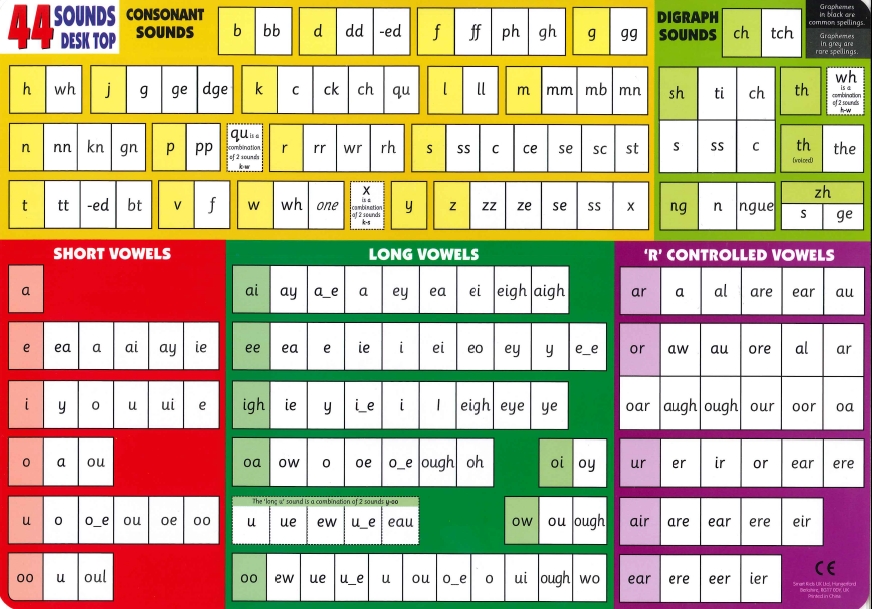Have you ever struggled to pronounce a word correctly, feeling lost in the labyrinth of English sounds? You’re not alone! English pronunciation can be a complex puzzle, with its seemingly endless variety of sounds and quirky spelling rules. But fear not, mastering English pronunciation is achievable, and the key lies in understanding the 44 distinct sounds that make up the language. In this comprehensive guide, we’ll delve into the fascinating world of English phonetics, exploring each of these sounds with clear explanations and illustrative examples. By the end, you’ll be equipped with the knowledge and tools to confidently pronounce any word with precision and fluency.

Image: www.youtube.com
The 44 sounds of English, known as phonemes, are the building blocks of spoken English. These sounds, represented by symbols from the International Phonetic Alphabet (IPA), provide a standardized system for accurately recording and understanding pronunciation. Unlike letters, which can represent multiple sounds, each phoneme corresponds to a unique sound. By breaking down spoken English into its fundamental sounds, you gain a powerful understanding of how words are pronounced and how to distinguish between similar-sounding words. This knowledge empowers you to improve your clarity, intelligibility, and overall confidence in speaking English.
Understanding the 44 Sounds: A Journey Through English Phonetics
Vowels: The Foundation of Sounds
Let’s begin our journey by exploring vowels, the basis of English pronunciation. Vowels, unlike consonants, are produced without obstructing airflow from the mouth. The shape of the mouth and the position of the tongue determine the different vowel sounds. English possesses 20 vowel sounds, categorized into monophthongs (single vowel sounds) and diphthongs (combinations of two vowel sounds), each with its own unique quality and pronunciation.
- Monophthongs: These are pure vowel sounds, like the ‘a’ in ‘cat’ or the ‘i’ in ‘bit’.
- Diphthongs: These are gliding sounds, where the tongue smoothly shifts positions between two vowels, like the ‘oy’ in ‘boy’ or the ‘ai’ in ‘rain’.
Consonants: Shaping the Soundscape
Consonants, on the other hand, are produced by partially or completely obstructing airflow in the mouth or nose. These sounds are further categorized based on where and how the obstruction is created, resulting in a diverse range of 24 consonant sounds in English.
Here’s a breakdown of the different consonant categories:
- Place of Articulation: This refers to the point in the mouth where the airflow is restricted (e.g., lips, teeth, back of the tongue).
- Manner of Articulation: This refers to the type of obstruction created (e.g., stopping airflow, creating friction, or creating a vibration).
- Voicing: This refers to whether the vocal cords are vibrating during the sound’s production (voiced) or not (voiceless).

Image: big-tree.com.sg
Learning the Sounds: Practical Resources and Exercises
Now that we’ve explored the different types of English sounds, let’s dive into the practical tools and techniques to master them:
The International Phonetic Alphabet (IPA): Your Sound Guide
The IPA is a vital tool for accurately representing spoken sounds. Each sound in the English language has a corresponding symbol in the IPA chart, allowing for precise pronunciation guide. This chart is a valuable resource for both learners and teachers of English.
Pronunciation Dictionaries: Your Key to Accurate Pronunciation
Pronunciation dictionaries, such as Merriam-Webster’s Visual Dictionary of English Usage, offer detailed pronunciation guides for every word in the English language. These dictionaries often include audio recordings and visual representations of mouth positions, making learning pronunciation intuitive and engaging.
Practice Makes Perfect: Engage in Exercises and Resources
Regular pronunciation practice is key to solidify your understanding of English sounds. Several online platforms and mobile applications offer a wealth of pronunciation exercises, games, and quizzes to test and improve your skills.
From Sounds to Sentences: Mastering Fluency and Articulation
Once you’ve developed a solid understanding of the 44 sounds, it’s time to put your knowledge into practice and build fluency in spoken English. Focus on the following aspects:
Stress and Intonation: Adding Rhythm and Meaning
Stress and intonation play a crucial role in conveying meaning in English. Proper stress placement on syllables and phrases adds rhythm and clarity to your speech, making it easier for others to understand you. Intonation, the rise and fall of your voice, further enhances meaning and emotions in your speech.
Rhythm and Pace: Flowing Naturally
English has a natural rhythm and pace that distinguishes it from other languages. Pay attention to the flow of words and phrases, ensuring that your speech sounds natural and conversational. This requires careful practice with pronunciation, stress, and intonation.
The Benefits of Mastering English Pronunciation
The benefits of mastering English pronunciation extend beyond clearer communication:
- Improved Communication: You’ll be understood more easily, leading to better communication and fewer misunderstandings.
- Increased Confidence: Pronouncing words correctly builds confidence in your ability to speak English.
- Enhanced Learning and Comprehension: Understanding how sounds are formed improves your ability to learn new words and understand spoken English.
- Greater Language Proficiency: Mastering pronunciation is a fundamental step towards achieving fluency in English.
44 Sounds Of English With Examples Pdf
Conclusion: Your Journey to Perfect Pronunciation
Mastering the 44 sounds of English is a rewarding journey that opens doors to clearer communication, increased confidence, and greater language proficiency. By diligently studying the IPA, practicing pronunciation exercises, and applying your knowledge in real-world situations, you can unlock the secrets of English pronunciation and become a confident and articulate speaker.
Remember, learning a language is a continuous process. Don’t get discouraged if you stumble along the way; celebrate your progress, embrace the challenges, and enjoy the journey! The more you practice, the more fluent and confident you’ll become. And who knows, you might even discover a newfound appreciation for the beauty and complexity of the English language.




